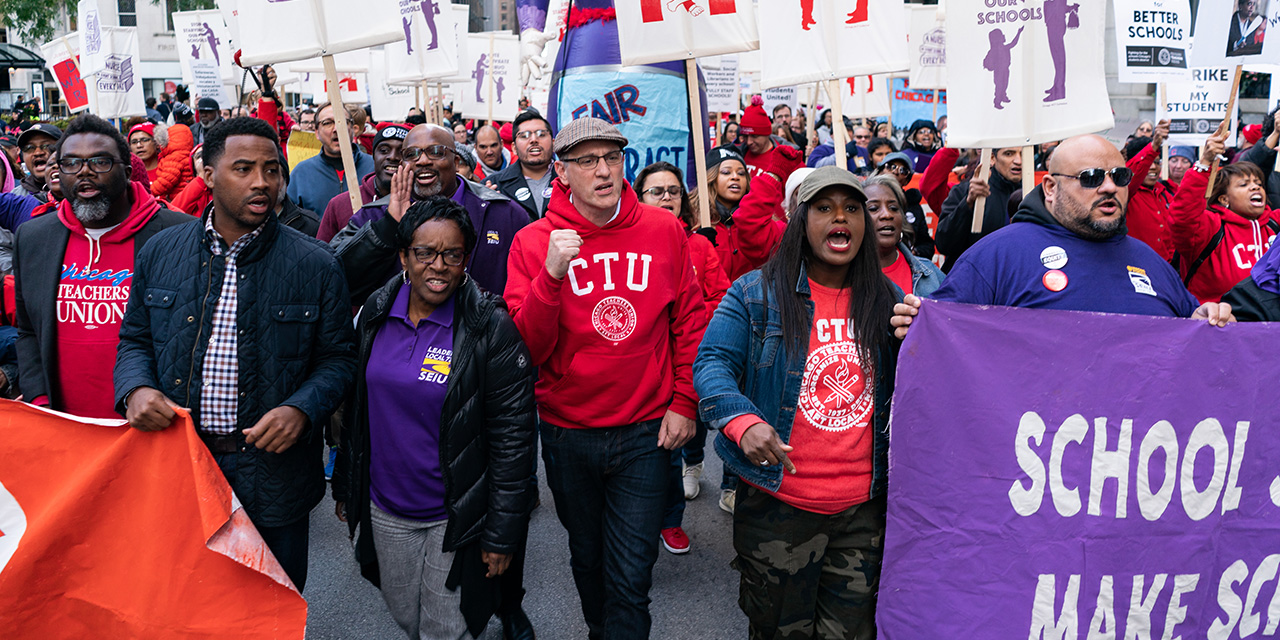
Democratic mayoral nominee Zohran Mamdani has made some bold promises on education, including ending mayoral control of city schools, making CUNY tuition-free, and hiring “thousands more teachers.” To evaluate the merits of these ideas, readers might look 800 miles west.
In Chicago, leaders adopted a similar playbook. They escalated school budgets, swelled payrolls, and granted effective union veto power over policy. Today, the Windy City is home to half-empty classrooms, woeful student-proficiency rates, and a school system lurching toward insolvency.
Finally, a reason to check your email.
Sign up for our free newsletter today.
In 2023, Chicago elected Brandon Johnson, a former teacher and union organizer, backed by the Chicago Teachers Union, as mayor. His campaign was bolstered by $7.2 million dollars in union funds, constituting 95 percent of his total received donations.
As mayor, Johnson has embraced a union-first approach to education. In late 2024, the entire Chicago Board of Education resigned, reportedly under pressure, after months of tension between Johnson and the Chicago Public Schools (CPS). This allowed Johnson to replace the board members with hand-picked allies who would “carry out his wishes,” per Chalkbeat Chicago.
One of the new board’s first actions was to extend the no-closure pledge, which prevents CPS from shutting down any school, no matter how underperforming, until 2027. While the move was a boon to teachers’ unions, research has shown that closing failing schools, rather than keeping them open, improves student achievement.
Earlier that year, as part of the $9.9 billion CPS budget, the Chicago Board of Education agreed to spend about $30,000 per student—nearly double the national average. The budget increase, which came despite a 7.4 percent drop in student enrollment since 2020, reflected a union-driven push to expand CPS’s staff. Between 2020 and 2024, funding and staffing for the city’s public schools rose 21 percent and nearly 19 percent, respectively, even with thousands fewer children in the system.
Today, CPS faces projected deficits near $1 billion as pandemic-era funds dry up, with the district and union clamoring for more state aid. What has all this money and hiring done for Chicago’s students? By most measures, nothing good.
Academic outcomes in Chicago are alarming. The latest state assessment found that 40 percent of CPS students are chronically absent. Fewer than one in three elementary school students can read at grade level, and barely one in five is proficient in math. Among high schoolers, the results are even worse—in 2024, less than 23 percent and 19 percent of Chicago eleventh-graders could read or do math at grade level, respectively. In dozens of Chicago schools, not a single student can do math or read proficiently. In fact, during the 2021–2022 school year, 55 Chicago schools had zero students who could read or do math at grade level—an astonishing failure in schools that ostensibly exist to educate.
Like Brandon Johnson, Zohran Mamdani enjoys heavyweight labor endorsements, including from the United Federation of Teachers and the New York City Central Labor Council. These could signal the democratic socialist’s desire to pursue a union-first governing style similar to Johnson’s in Chicago.
The UFT’s endorsement of Mamdani is no shock, as he has promised to relinquish mayoral control over the city’s education system, effectively handing the union the keys to New York City schools.
Mayoral control in New York has not only mitigated the risk of a union takeover but has also led to greater school choice and ultimately paved the way for some of the city’s most successful educational programs. Former mayor Michael Bloomberg’s charter school initiative, which remains immensely successful, was possible only because mayoral control gave him the authority to open charters over union opposition.
The success of Gotham’s charter schools is reflected in the 2024 state exam results. More than 58 percent of New York City charter school students were proficient in English, compared with 49.1 percent in traditional district schools. The charter edge in math was even greater, with 66.3 percent of charter students achieving proficiency compared with 53.4 percent in district schools.
Strikingly, black and Hispanic students in charter schools outperformed their district counterparts in math by 27.5 and 24 percentage points, respectively. Even disabled students saw better outcomes, with proficiency rates in charters nearly double those of such students in union-run schools. In the Bronx, charter academies attained 66.7 percent math proficiency—some 28 points higher than the local district average.
These results are no coincidence. Freed from union mandates and bureaucratic inertia, charter educators working under mayoral oversight can innovate, set high standards, and be held accountable when they fail. It’s no wonder that families are flocking to charters: over the past five years, New York City charter school enrollment has surged nearly 14 percent, even as district school enrollment plunged by more than 11 percent. The lesson is clear—mayoral control and charter autonomy have delivered for students, and New York should not revert to union control.
Chicago presents a clear warning that New York ought to heed. Allowing unions to drive education policy doesn’t yield what Mamdani calls “co-governance.” Instead, it results in failing schools—and thousands of children failing to reach their potential.
Photo by Max Herman/NurPhoto via Getty Images
City Journal is a publication of the Manhattan Institute for Policy Research (MI), a leading free-market think tank. Are you interested in supporting the magazine? As a 501(c)(3) nonprofit, donations in support of MI and City Journal are fully tax-deductible as provided by law (EIN #13-2912529).
Source link

















